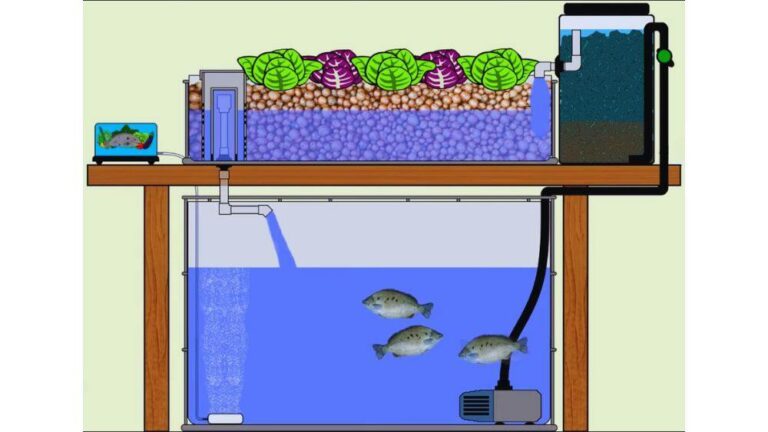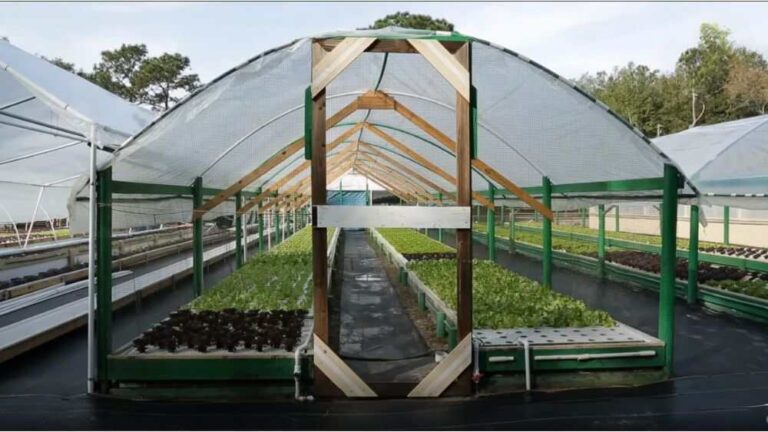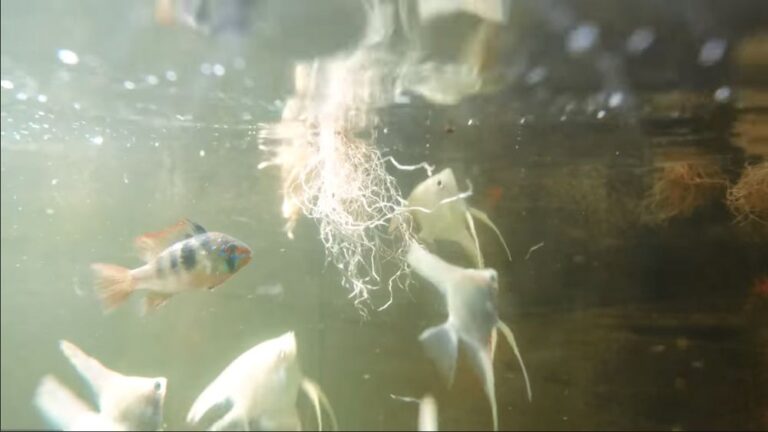Hydroponic Garden with Fish Tank: Sustainable Greenery
Hydroponics with fish systems, or aquaponics, is a creative and eco-friendly way to grow plants and raise fish together. Fish waste produces nutrients for plants and plants absorb them to clean water for fish. It’s a win-win situation that saves water, space, and money.
You can install your aquaponic system at home with essential equipment and materials. In this article, we’ll show you how to do it and what plants and fish are best suited to this type of gardening. Ready to get started?

Hydroponics with Fish: An Overview
What is hydroponics with fish?
Hydroponics with fish gardens is a smart way to grow plants and fish in harmony. It combines aquaculture and hydroponics in an autonomous system. That means you don’t need soil, fertilizer, or much water. You just need a tank, a pump, and some pipes. Besides benefiting the environment, it’s also cost-effective.
Sustainability at Its Best
If you care about the environment, you will love this idea. It is a natural way of growing plants and fish in the same arrangement. It is where fish and plants help each other grow with minimal inputs and waste. This way, you waste nothing and save energy and water.
Setting Up Your Hydroponic Garden With Fish
A Step-by-step Guide
A hydroponic garden with a fish system is an excellent way to grow food and enjoy aquatic beauty. The setup steps are as follows:
Choose your fish: Not all fish are suitable for this type of gardening. Tilapia and catfish are ideal because they tolerate different water conditions and produce waste, fertilizing plants.
Get a tank: You need a tank that can hold enough water and fish for your system. The tank size should match your plant needs and space availability.
Install the hydroponic system: You need a grow bed that sits on the tank and holds the plants. A growing medium, such as clay pellets or gravel, is also required to support the plant roots and allow water to flow through.
Pump the water: You need a pump that supplies water from the tank to the grow bed and back. Thus, the provided water carries the nutrients the fish waste produces, and the plants absorb them.
Add an air stone: You need one that bubbles air into the water. It helps oxygenate the water for both fish and plants.
Plant your crops: You can plant almost any hydroponic plant in your system, such as lettuce, herbs, tomatoes, or strawberries. Just place them in the grow bed and let them grow.
Monitor and maintain: You must regularly check the water quality, pH levels, and fish health. You must also feed the fish, prune the plants, and clean the tank.

Choosing Plants for Hydroponics with Fish
Aquaponics lets you grow plants and fish simultaneously in a symbiotic system. However, not all plants are suitable for this method. You need to consider the water quality, temperature, and pH level your fish prefer. Here are some of the most suitable aquaponic plants:
Lettuce: This leafy green thrives in aquaponics, is fast to harvest, and is crisp to eat.
Basil: It needs a lot of nutrients, which the fish provide.
Tomatoes: They produce lots of fruit if you give them enough support.
Mint: It spreads quickly and can handle wet and moist conditions.
Cilantro: It tolerates aquaponics well and spices up your dishes.
You can experiment with different plants, but make sure they match your fish’s needs.
Fish Tank Hydroponic System Design
A fish tank hydroponic system can be aesthetically pleasing and practical to grow plants and keep fish. It is an art that combines the needs of your aquatic friends with the lush greenery above. However, meticulous planning and design are needed to balance the needs of both parties. Here are some tips for creating an effective system with aesthetic considerations:
Designing an Aesthetically Pleasing Garden
Your aquaponic system can be both functional and visually appealing. Here’s how to strike that balance:
Aquarium Placement: Choose a spot with enough natural or artificial light for your plants. A well-lit fish tank promotes plant growth and creates a pleasing aesthetic impression.
Plant Arrangement:
- Think outside the box when arranging plants together.
- Set them up so that they fit and are aesthetically pleasing to the water where your fish live.
- Create a captivating display with plants of various heights and colors.
Decorative Elements: Add some decorations to the tank, like rocks, driftwood, or ornaments that float in the water. These not only look better, but they also give your fish places to hide and stay safe.
Making sure that fish and plants’ needs are met
You need to choose the right fish and plants to make your system work well. Here are some tips:
Fish Health: Keep your fish happy and comfortable. Check the water pH, temperature, and oxygen level regularly. Different fish have different needs, so research your chosen species carefully.
Plant Selection: Pick plants that thrive in aquaponics. Herbs like basil, leafy veggies like lettuce, and fruiting plants like tomatoes are good choices.
Nutrient Levels: Monitor the nutrient levels in the water. Fish waste provides most of the nutrients plants require, but you may need to supplement with minerals if necessary. You should test and adjust the water regularly.
Incorporating Aquaponics Principles
Aquaponics combines fish farming and hydroponics to produce food efficiently. To succeed in aquaponics, you need to master these three skills:
How fish waste becomes plant food: Fish produce ammonia, which is toxic to them. But bacteria in the water convert it to nitrites and then nitrates, which are suitable for plants. It is called the nitrogen cycle, and it’s essential for water cleanliness and health.
How plants and fish help each other: Plants use the nitrates from fish waste as fertilizer, and in return, they filter the water for the fish. It is a symbiotic relationship, and it’s the basis of aquaponics.
How to learn and adapt: Aquaponics is not a one-size-fits-all method. It changes depending on your system, environment, and goals. Experimentation and learning are the keys to success. The most effective way to do that is by doing it.
Understanding these three concepts can help you get the most out of aquaponics and enjoy growing your own food.

Tips for Successful Hydroponics with Fish Tank
You’ve done a great job setting up your water garden. Now, let’s make sure it thrives. Here are some key things to do:
Maintaining Water pH and Temperature
pH Levels: The water pH should be slightly acidic to neutral (around 6.5-7.0), which will help your plants and fish obtain the nutrients they need.
Temperature Control: Keep the water temperature within your fish’s comfort range. Fish species have different preferences, so check what’s right for you.
Monitoring Fish Health and Well-being
Observation: Watch your fish for signs of stress or sickness. If you notice anything wrong, act fast. Your fish are the heart of your system.
Quality Feed: Feed your fish high-quality food that matches their species. Well-fed fish produce more nutrient-rich waste, which benefits your plants.
Troubleshooting Common Issues
Algae Control: Too much algae can harm your system. Limit light exposure, lower nutrient levels, and add algae-eating fish like shrimp to your system to prevent this.
Clogged System: Check the lines, grow beds, and filters regularly. Clogs can disrupt the water flow and damage your system.
Maximizing Plant Growth and Yield
To get the most out of your plants, prune and harvest them regularly. Pruning helps your plants grow more branches and leaves, providing more food for your fish. The harvesting of fruits and vegetables encourages plants to produce more. As a result, you get more yield and food. Here’s how to do it:
Pruning:
Prune your plants every week or two, depending on how fast they grow.
Cut off dead, diseased, or yellow leaves and dry stems.
Trim any branches that are too long or too close to each other. It will prevent overcrowding and improve air circulation.
Harvesting:
Please go ahead and harvest your crops when they are ripe and ready.
Please don’t wait too long; they will lose their flavor and nutrients.
Don’t pick them up too early, or they will be underdeveloped and tasteless.
Check the signs of maturity for each plant type and choose them accordingly.
You can enjoy a bountiful harvest from your fish tank hydroponic system by following these simple steps.
Benefits of Aquaponics With a Fish Tank
Aquaponics with a fish tank has many benefits for you and the environment. Here are some of them:
Save water: Aquaponics with a fish tank use up to 90% less water than conventional gardening because water is recycled between the plants and the fish. That means you can grow more food with less water and conserve this precious resource.
To avoid soil pollution and chemical runoff: Aquaponics with a fish tank do not require soil or synthetic fertilizers, which can contaminate the land and waterways.
Grow nutrient-rich food: The plants in your aquaponics with a fish tank system get all the nutrients they need from fish waste, making them healthy and tasty. You can also enjoy fresh fish free of antibiotics and hormones. You can grow various vegetables, herbs, and edible fish such as tilapia, catfish, or trout.
Produce food sustainably: Aquaponics with a fish tank is a self-sufficient system without external inputs or outputs. You can grow food all year round, regardless of the weather or season. You can also scale your system up or down according to your needs and space.
Spend less: By growing your own food, you can cut down on grocery bills and eat better. You can also sell your surplus produce or fish to your neighbors or local markets and earn extra income.
Aquaponics with a fish tank is an intelligent way to grow food that is easy to set up, maintain, and enjoy.

FAQs
What is hydroponics with fish, and how does it work?
Hydroponics with fish is also called aquaponic farming. You don’t need soil or chemicals, just fish and water. Fish poop nourishes plants, which leads to fish growth in clean water. You can use this method to grow fresh food in your backyard or even indoors.
What types of fish are suitable for a fish tank hydroponic system?
Tilapia, catfish, and trout are some of the most common fish that thrive in aquaponic systems. Moreover, these fish are easy to care for, produce a lot of waste that fertilizes the plants, and can adjust to different conditions.
Can I grow any plants in a fish tank hydroponic system?
A fish tank hydroponic garden lets you grow plants from fish waste. Choose plants that can handle aquaponic conditions. Leafy greens and herbs are the best choices. You can also grow tomatoes and other fruits.
How do I maintain aquaponic water quality?
To keep your fish healthy:
Check the pH levels often and keep them around 6.5–7.0.
You should monitor the temperature, oxygen, ammonia, nitrite, and nitrate levels.
Change some water when needed, and don’t feed your fish too much.
What are the environmental benefits of hydroponics with fish systems?
Hydroponics with fish systems, or aquaponics, is a sustainable way to grow food. Because the water is recycled between the plants and the fish, it uses up to 90% less water than traditional gardening.
It also avoids synthetic fertilizers, which pollute the environment and harm the soil. Aquaponics produces both vegetables and fish, reducing waste and increasing food security.
What are the disadvantages and challenges of aquaponics with a fish tank?
While aquaponics with a fish tank is an eco-friendly and efficient gardening method, it can present some challenges. These can include the initial setup cost, the need for continuous monitoring, and the learning curve associated with maintaining a balanced ecosystem. However, many enthusiasts find the benefits far outweigh the challenges.
How can I start a fish tank hydroponic system at home?
Here’s how to set up a fish tank hydroponic system at home:
- Find a spot with enough light and space for your tank and plants.
- Choose plants that don’t need soil, like lettuce, herbs, or strawberries.
- – Choose hardy fish that produce waste, like goldfish or tilapia.
- Install a pump, a filter, and a grow bed to connect the tank and the plants.
- Monitor the water quality, the pH, and the nutrients regularly.
Start with a small system and learn from your mistakes. Enjoy the fruits of your labor when growing vegetables and fish.
As a final note
In conclusion, aquaponics is an intelligent farming technique that combines hydroponics with fish systems. It allows you to grow plants and fish simultaneously in a system that recycles water and nutrients, reduces waste and pollution, and produces healthy food. Hydroponic gardening with fish is also beneficial for your garden and environmentally friendly.
If you want to join the aquaponics movement and support sustainability, you can start by setting up a fish tank in your hydroponic system. You can also see the results.
Act now
We’d love to hear about your experiences with hydroponics and fish systems. Have you tried this new gardening method? If not, it makes me want to. Next, tell us about your garden and show us pictures and stories about it.
Together, we will explore both the benefits and challenges of this sustainable and thrifty gardening approach. Let’s dive into aquaponics and see what it can do for you and the planet. Ready to get your hands wet?

Meet Milan Cole, your urban gardening pro!
Milan Cole, chief content writer at Maven Gardening and an urban gardening expert, is passionate about helping city dwellers cultivate their green thumbs. Armed with extensive horticultural knowledge, Milan provides practical advice for overcoming urban gardens’ challenges, like limited space, water scarcity, and reduced sunlight.
His expertise extends beyond traditional methods, encompassing innovative approaches like hydroponic and aquaponic systems and sustainable gardening practices. Milan skillfully adapts these techniques to urban environments, considering factors like pollution and climate change.
In his clear and concise writing, Milan offers actionable solutions for anyone wanting to bring life to an urban space. He shares valuable insights into growing herbs in tight spaces, maximizing the potential of window boxes, and transforming even the most miniature balconies into thriving green oases.
Milan’s guidance is straightforward and practical, making it ideal for anyone looking to cultivate their own urban garden, regardless of prior experience.
Join Milan Cole on your journey to metropolitan Eden!
